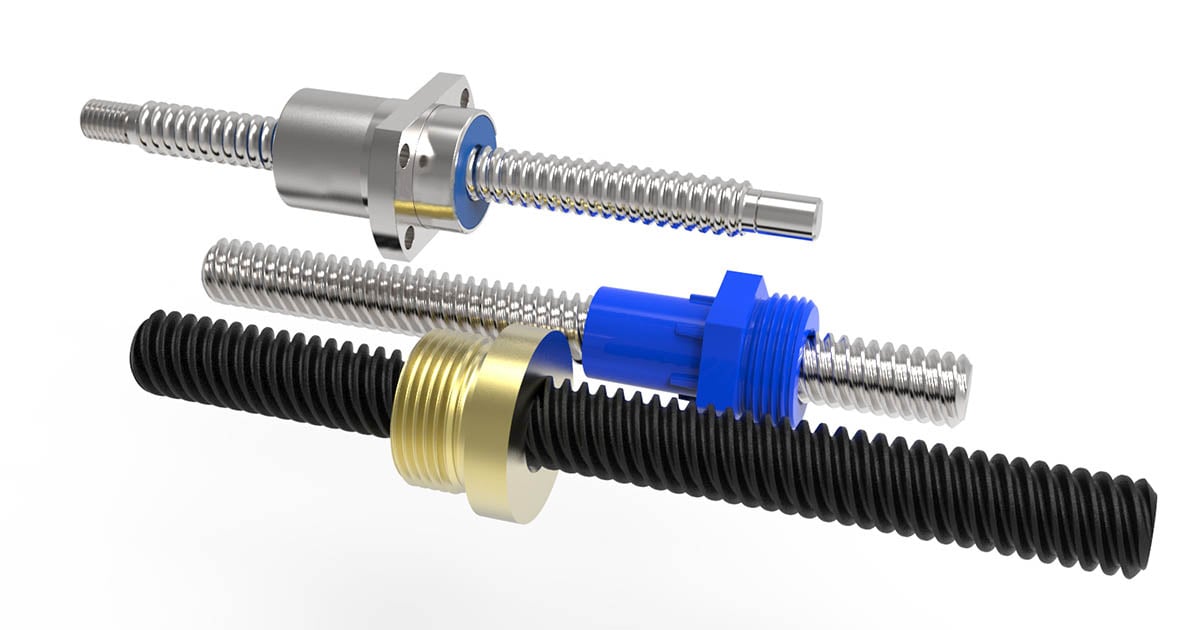The Pros and Cons of Acme Screws vs Ball Screws

Lead screws and ball screws have been the most trusted and cost-effective means of converting rotary motion to linear motion. Both employ a thread form and nut; however, ball screws utilize balls between the nut and screw threads to reduce friction.
Ball screws, as known today, were developed in the 1940s by General Motors for automotive steering gear and in World War II to help extend flaps on bomber's wings. These extensions helped provide more payload. This proved to be an effective technology and is still used today in most modern aircraft and automobiles. The technology was similar in concept to radial ball bearings and plain bushings. Further development of ball screws increased accuracy, decreased backlash, improved loading, and lowered manufacturing costs, opening up additional opportunities for their application, especially in machine tools. Ball screws are costly to manufacture due to the number of precision components utilized in their manufacture. They are also bulky and noisy because the balls whirl around the threads and transfer from end to end. Ball screws require lubrication (grease) which is frowned upon in medical, semiconductor, instrumentation, food processing, and environmental concerns.
Lead screws were used in less demanding applications as the early nut materials were limited to cast iron, Babbitt lined, and bronze. Because of metal-on-metal sliding friction, Acme screws' efficiency was low and required more power to move the same load as a ball screw. Additionally, they required copious amounts of lubrication and started wearing them as soon as they were placed in service.
Babbitt-lined Acme nuts were the first attempt to extend the life and lower friction by creating an alloy of material that was composed of copper and antimony dispersed through a softer metal tin. These thinly lined Babbitt nuts allowed lubrication access to the internal part of the nut as the tin wore and the other materials supported the load. Early manual machine tools took advantage of the reduced friction and extended life. However, the human compensation for nut wear could not be built into the computer-driven machines.
Office automation, especially printers, creates a need for high-speed, low-cost linear motion actuation. Due to noise in the office environment, ball screws were eliminated early on, and engineering efforts were focused on Acme screws. New polymers, especially the injection-molded type, allowed for new designs that have plenty of advantages. Many of them are reinforced with carbon fiber or glass and self-lubricating with PTFE and other lubrication packages. They minimize wear, have high load capacities, preload, provide corrosion resistance, and are very quiet running. These new screws use 300 series stainless steel and are precision roll-formed to cut costs.
An essential advantage of roll forming is the roller burnishing effect of the screw, providing exceptionally smooth operation. New technologies in thread rolling also offer a very accurate screw profile, allowing for multiple shallow starts. PTFE coatings for the screws were developed to provide dry lubrication, eliminating messy wet lubrication. High lead screws are rolled to optimize the fast operation of the printers. New nut designs were created to facilitate preload to enhance print accuracy and print in both directions. These preloaded nuts not only helped with the print resolution, they automatically adjusted for nut wear, ensuring years of real trouble-free life.
The great news is that the technology designed to solve any office machine problem has been successfully ported over to other industries. With further advancements in polymers, higher loads are achieved, and operation efficiencies keep getting better. We now find these types of screw assemblies in entertainment, packaging, transportation, factory automation, material handling, weapons systems, machine tools, aerospace, medical equipment, semiconductor, and other industries.
Learn More in Our Engineers Guide
We want to offer some more information about acme lead screws vs. ball screws in the form of our "Precision Miniature Lead Screw Assemblies" catalog. This catalog is a comprehensive guide to selecting the correct lead screw assembly for your linear motion technology.


